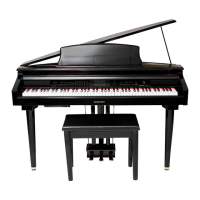
Do you have a question about the Suzuki Micro Grand Digital Piano and is the answer not in the manual?
| Polyphony | 128-note |
|---|---|
| Effects | Reverb, Chorus |
| MIDI | Yes |
| Transpose | Yes |
| Tuning | Yes |
| Metronome | Yes |
| USB | Yes |
| Pedals | Sustain, Soft, Sostenuto |
| Headphone Jack | Yes |
| Touch Response | 3 levels |
| Power Supply | AC adapter |
| Keyboard | 88-note, fully weighted, hammer action keyboard |
General safety advice for using electrical products.
Instructions for moving and handling the piano.
Methods for cleaning and environmental conditions to avoid.
Guidelines for servicing, modifications, and power handling.
Controls for master/accompaniment volume and tempo.
Button to turn the piano on and off.
Features for harmony, layering, and split mode.
Sets auto accompaniment into standby mode.
Controls for starting, stopping, and ending rhythm styles.
Selecting variations and inserting fill patterns.
Selects the auto accompaniment mode and fingering.
Buttons for quick selection of instrument voices and rhythm styles.
Alternating selection lines and metronome toggle.
Controls for selecting voices, styles, and using the music teacher.
Accessing and navigating the function menu.
Stores and recalls keyboard settings.
Inputting numbers and shifting pitch.
Controls for reverb and chorus effects.
Practice modes for built-in songs.
Buttons for recording, playback, and track selection.
Engages SD memory card functions.
Inputs for microphone, headphones, and audio sources.
Ports for MIDI communication and computer connection.
Pedals for volume/timbre control and note sustain.
Center pedal for triggering various events.
Buttons for quick selection of instrument voices.
Method to select any voice by number.
Assign favorite voices to quick select buttons.
Modes for mixing voices or splitting the keyboard.
Sets the split point for voice division.
Buttons for quick selection of rhythm styles.
Method to select any style by number.
Assign favorite rhythm styles to quick select buttons.
Modifying tempo and controlling rhythm style playback.
Methods for starting, varying, and filling rhythm patterns.
Sets the split point for auto accompaniment.
Modes for fingering auto accompaniment.
Simple chord creation with minimal fingers.
Play chords using knowledge of chord structures.
Table of chord names and their fingering.
Modes for playing chords anywhere or using manual bass.
Adding harmony and starting/stopping accompaniment.
Methods for starting, varying, and filling rhythm patterns.
Sets the split point for auto accompaniment.
Adjusting time signature and tempo for the metronome.
Adjusts the intensity of the reverb effect.
Adjusts the intensity of the chorus effect.
Sets keyboard touch sensitivity levels.
Adjusts the split point for the lower voice.
Adjusts the split point for auto accompaniment.
Adjusts the overall pitch of the piano.
Selects the type of auto harmony.
Setting up and selecting songs for recording.
Choosing melody or accompaniment tracks to record.
Methods for recording melody, accompaniment, or both.
Methods to stop the recording process.
Stores current settings into memory.
Retrieves previously saved settings.
Overview of card functions and handling.
Plays all SMF MIDI songs from the SD card.
Loads songs from the SD card into the sequencer.
Saves recorded performances to the SD card.
Manages MIDI file tracks and deletes files.
Details on connecting MIDI devices and data flow.
Explains the function of MIDI channels.